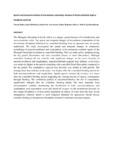Please use this identifier to cite or link to this item:
https://cris.library.msu.ac.zw//handle/11408/3230Full metadata record
| DC Field | Value | Language |
|---|---|---|
| dc.contributor.author | Dube, Trevor | - |
| dc.contributor.author | DeNecker, Lizan | - |
| dc.contributor.author | van Vuren, Johan H. J. | - |
| dc.contributor.author | Wepener, Victor | - |
| dc.contributor.author | Smit, Nico J. | - |
| dc.contributor.author | Brendonck, Luc | - |
| dc.date.accessioned | 2018-10-03T15:30:49Z | - |
| dc.date.available | 2018-10-03T15:30:49Z | - |
| dc.date.issued | 2017 | - |
| dc.identifier.issn | 0270-5060 | - |
| dc.identifier.uri | https://www.researchgate.net/deref/http%3A%2F%2Fdx.doi.org%2F10.1080%2F02705060.2016.1230562 | - |
| dc.identifier.uri | http://hdl.handle.net/11408/3230 | - |
| dc.description.abstract | The Phongolo floodplain in South Africa is a unique system because of its biodiversity and socio-economic value. The spatial and temporal changes of invertebrate communities of the downstream floodplain influenced by controlled flooding from an upstream dam are poorly understood. The study investigated the spatial and temporal changes in community assemblage of macroinvertebrates and zooplankton in the permanent wetlands (pans) of the Phongolo floodplain in relation to controlled flooding. This was achieved by sampling during the dry period (September) and after controlled release of water (December). Although controlled flooding did not coincide with significant changes in the taxon diversity of macroinvertebrates and zooplankton, macroinvertebrate regional taxa richness (γ-diversity) was relatively higher in the period coinciding with controlled flood (December) compared to the dry period. For zooplankton, regional taxa diversity was similar in both periods. The average local taxa richness (α-diversity) was higher after the controlled flooding period for both macroinvertebrates and zooplankton. Spatial species turnover (β-diversity) was lower after the controlled flooding period suggesting the homogenization of aquatic communities through flooding. The community pattern of macroinvertebrates, but not of zooplankton, significantly changed after the controlled flooding period. The most important local environmental variables determining the distribution of both macroinvertebrates and zooplankton were macrophyte cover and dissolved oxygen. As the invertebrate diversity in this unique floodplain is at least partly dependent on release of water from the dam, future management schemes aimed to meet irrigation demands for agriculture should always consider flooding of the precious floodplain wetlands to maintain ecosystem integrity. | en_US |
| dc.language.iso | en | en_US |
| dc.publisher | Taylor & Francis | en_US |
| dc.relation.ispartofseries | Journal of Freshwater Ecology;Vol. 32, No. 1: p. | - |
| dc.subject | Regulated flow | en_US |
| dc.subject | Diversity | en_US |
| dc.subject | Pans | en_US |
| dc.subject | Phongolo floodplain | en_US |
| dc.title | Spatial and temporal variation of invertebrate community structure in flood-controlled tropical floodplain wetlands | en_US |
| dc.type | Article | en_US |
| item.fulltext | With Fulltext | - |
| item.languageiso639-1 | en | - |
| item.openairetype | Article | - |
| item.openairecristype | http://purl.org/coar/resource_type/c_18cf | - |
| item.grantfulltext | open | - |
| item.cerifentitytype | Publications | - |
| Appears in Collections: | Research Papers | |
Files in This Item:
| File | Description | Size | Format | |
|---|---|---|---|---|
| Spatial and temporal variation of invertebrate community structure in flood.pdf | Abstract | 458.3 kB | Adobe PDF |  View/Open |
Page view(s)
190
checked on Oct 23, 2025
Download(s)
28
checked on Oct 23, 2025
Google ScholarTM
Check
Items in MSUIR are protected by copyright, with all rights reserved, unless otherwise indicated.



